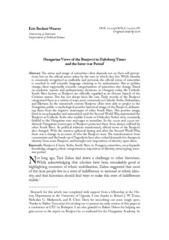| dc.description.abstract | The status and image of minorities often depends not on their self-perceptions, but on the official stance taken by the state in which they live. While identity is commonly recognized as malleable and personal, the official status of minorities is couched in stiff scientific language claiming to be authoritative. But as polities change, these supposedly scientific categorizations of minorities also change. Based on academic reports and parliamentary decisions, in Hungary today the Catholic South Slavs known as Bunjevci are officially regarded as an obscure branch of the Croatian nation. This has not always been the case. Early records of the Bunjevci categorized them in a variety of ways, most commonly as Catholic Serbs, Dalmatians, and Illyrians. In the nineteenth century Bunjevac elites were able to project to the Hungarian public a mythological positive historical image of the Bunjevci, delineating them from the negative stereotypes of other South Slavs. This positive image, fixed in encyclopaedias and maintained until the Second World War, represented the Bunjevci as Catholic Serbs who (unlike Croats or Orthodox Serbs) were constantly faithful to the Hungarian state and eager to assimilate. In the 1920s and 1930s traditional Hungarian stereotypes of Bunjevci protected them from abuses suffered by other South Slavs. As political relations transformed, official views of the Bunjevci also changed. With the massive upheaval during and after the Second World War, there was a change in accounts of who the Bunjevci were. The transformation from communism and the break-up of Yugoslavia have also evoked demands for changes in identity from some Bunjevci, and brought new impositions of identity upon them. | en |

